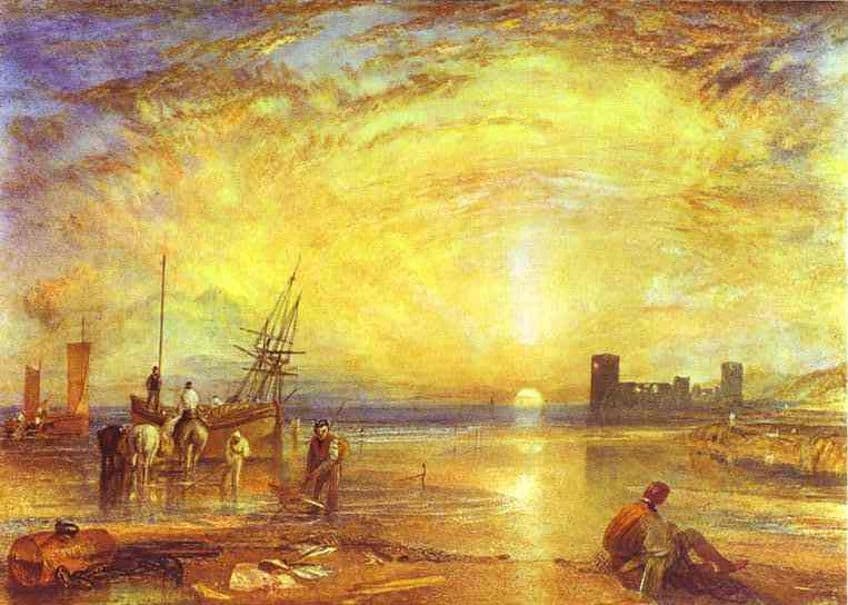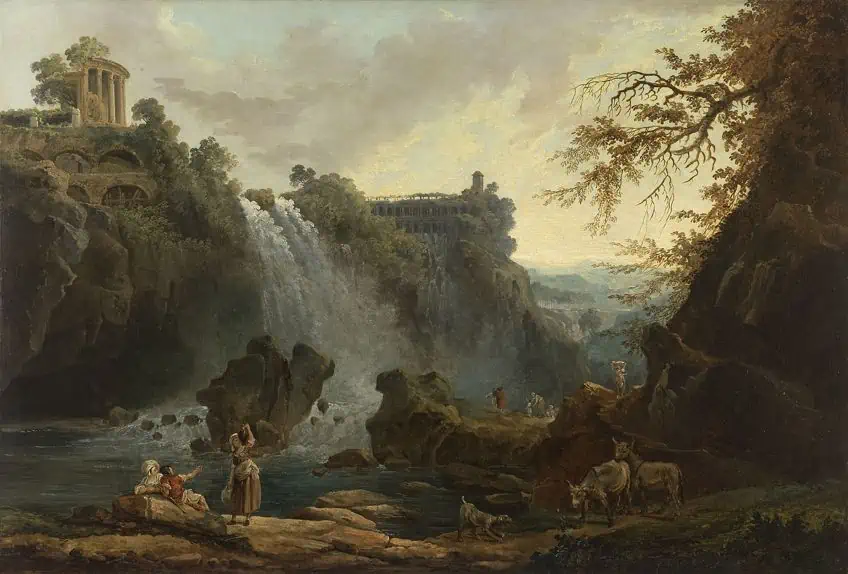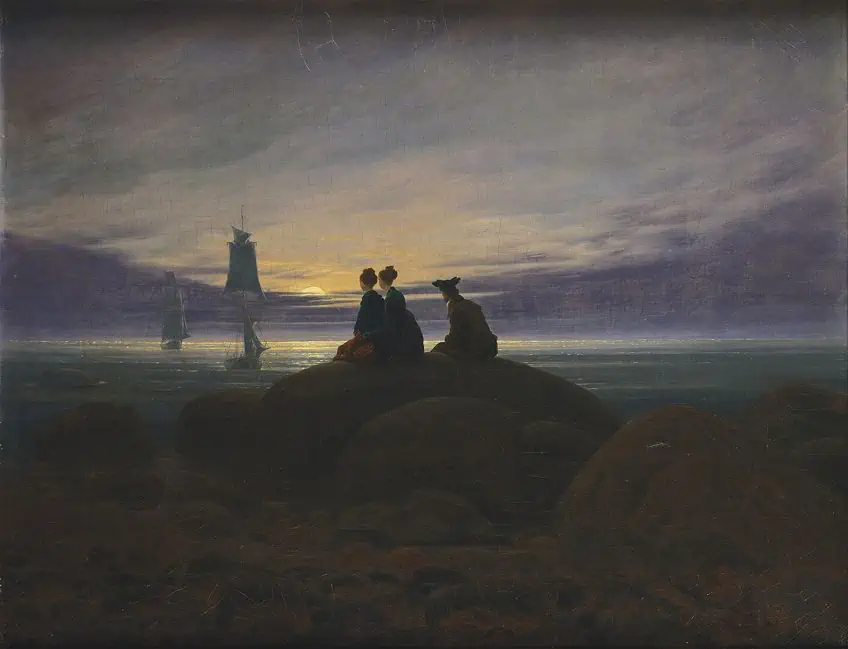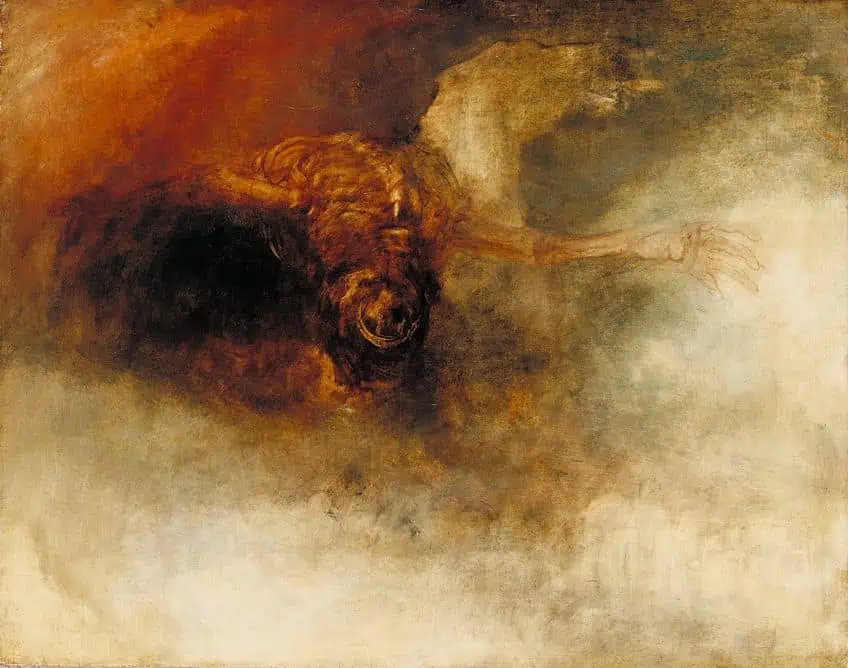Sublime Art – The History of Highly Emotive Art
You may have heard of the Sublime art movement, but what does sublime mean? What did the Sublime art movement entail? How can you define “sublime” in art? These are a few questions you may have on the elusive concept of the sublime, which we will introduce to you in this article. The notion of the sublime in art was formed in the mid-18th century and referred specifically to a liminal space that exceeds anything measurable. The acknowledgment of the existence of such a concept is something that not many have been able to wrap their brains around, but we will gladly unpack this concept with you through various examples of sublime art that will enrich your mind and enlighten your senses.
Contents
The Notion of the Sublime in Context
“The Sublime leads the listeners not to persuasion, but to ecstasy”. The Anglo-Irish statesman, Edmund Burke, published a philosophical inquiry into the concept of the sublime in a book called A Philosophical Enquiry into the Origin of our Ideas of the Sublime and Beautiful (1757). You might wonder how one had even imagined the word sublime in the 18th century, but many tend to forget that the 18th century was a period of mass political expansion as the British Empire gained its status as the world’s leading colonial power. This was also a period in England that saw the wealthiest and the poorest of people across the population with London reaching a population of close to one million residents.

What does this have to do with the sublime? People were increasingly aware of the state of their conditions and the conditions of their existence. Philosophy offered an outlet for reasoning during the 18th century with the great “age of reason” promoted by the Enlightenment and was a defining aspect that characterized the European world and was marked by the Napoleonic Wars, socio-political satire, gothic-horror fiction, and a general emphasis on rationality over superstition. The British Revolution had also commenced only three years after Burke published his philosophical inquiry. Needless to say, the age of reasoning was incredibly significant to the birth of concepts like the sublime in art.
The Sources of the Sublime
How can you define “sublime” in art? Regarding the source of the sublime, art history draws from the discipline of literature. The notion of the sublime made its debut around 1 AD with unknown origins but has been designated to an ancient Roman literary critique known as Longinus: Peri Hupsous, also known as, On the Sublime. The treatise’ author remains a mystery yet it has been speculated that a writer named Cassius Longinus produced the text.
The text examines both good and bad modes of writing, which is supported by the concept that references the elevation of writing to a style that is “above the ordinary”.
The text also identifies five sources of sublimity: strong emotions, great thoughts, noble diction, specific figures of thought and speech, and a signified word arrangement. The two dominant sources of the sublime, according to the ancient text, are the inborn sources, which stem from both a drive toward “vigorous concepts” and emanate from a powerful and passionate desire or goal. The other source is known as the acquirable source, which includes a selection of the correct lexicon, rhetorical devices, and the sublime birthed out of a “dignified” or “high composition”.
What Does Sublime Mean?
Edmund Burke defined sublime in the 18th century as an artistic effect that evokes the strongest emotion that one could experience. “Whatever is in any sort terrible or is conversant about terrible objects or operates in a manner analogous to terror is a source of the sublime”. The sublime can therefore be thought of as an effect of the unknown sublime, which may seem like an evasive concept that walks around the void of “not truly knowing” the source but is best identified through an extreme or heightened expression or emotional state.

The Sublime in Art History
In the broader art historical context, the notion of the sublime may have not been used intentionally but there are a few artworks from the past that do evoke the philosophical theory of the sublime via the visual “aesthetic” of the sublime. So, what does sublime mean in an art context? Operating from the sublime also means expressing oneself from the sublime, such that its message can be identified through the stimulus of visual or sensory experience. Sublime art makes evident a particular intense occurrence or event and can be seen in sublime landscapes by English Romantic artist Joseph Mallord William Turner.
Longinus further discusses the effects of the sublime, which can be identified in the visual arts.
These include the loss of rationality, which is further described as an “alienation” that leads to an identification of the artist to their creative process coupled with a “deep emotion mixed in pleasure and exaltation”. Similar to the goal of the writer is the goal of the artist, and that is, to arouse emotion in their audience. In art, one might assume that the idea of the sublime is an escape from reality and most would argue that the purpose of art itself conceals itself behind a lifestyle, capitalist gain, or philosophical endeavor of self-discovery, but the sublime simply reminds one of the endless possibility of both life and death. Just as the great age of reasoning had a profound influence on the world and many of its atrocities that followed at the expense of the pursuit of knowledge, so too, does the notion of the sublime in art play a role in highlighting the potential emotional impact that art holds.

What Does the Sublime Evoke?
The sublime in art evokes feelings of veneration, awe, and the power to hold a significant influence. It is useful to remember that when thinking about the idea of the sublime, that one identifies its potential in not only binaries but as a sphere, from which the sublime and impact of the sublime emanates. The feelings inspired by the sublime can produce both upsetting and peaceful emotions in a similar way that Romantic art can.
However, the sublime remains elusive as a genre that can be applied to describe the visceral sense of work or the psychological atmosphere behind an artwork.
Examples of Sublime in Art
Concerning the sublime, art history saw the use of the concept in the 17th century as a feature of Baroque art and literature, which marked the rediscovery of the text and the rediscovery of the sublime. The treatise translated versions received both praise and disdain for its ability to illuminate the concept versus its presentation as being “too civilized” for the public of the 17th century to understand. We will now explore some of the most interesting examples of sublime art as seen in art history.

The Fire of Rome (1785) by Hubert Robert
| Artist Name | Hubert Robert (1733 – 1808) |
| Date | 1785 |
| Medium | Oil on canvas |
| Dimensions (cm) | 93 x 75.5 |
| Where It Is Housed | MuMa Le Havre, Le Havre, France |
Hubert Robert was a famous French Sublime artist whose works were even applauded by Denis Diderot, who was a prominent figure in French philosophy and art criticism. Hubert Robert created The Fire of Rome for exhibition at the Salon de Paris in 1767, which was well-received since the wider audience possessed an interest in his aesthetic and subject matter.
Robert’s trip to Rome between 1745 and 1765 greatly informed the trajectory of his career and aided in his establishment as a “painter of architecture” with the nickname “Robert of the ruins”. The theme of the painting is based on a fire that took place in Rome in 64 AD, which inspired Robert to incorporate his passion for architecture while simultaneously pleasing the masses and appealing to the source of the sublime – emotion.
The painting’s composition relies on the background of a blazing fire with the architecture of the bridge and stairs acting in contrast to the tragedy in the background.
The destruction of Rome presents two dynamics that when contrasted together, create room for powerful emotion. These include a confrontation of the power of history versus the power of the natural element, fire. The power of the fire is that it emanates light while destroying the historic city, which was always on a pedestal to man but in the face of nature, it cowers.
Robert also decided to add only female figures in the painting to appeal to the viewer’s emotions and placed the statue seen over the bridge directly above the woman and her child. This was a psychological move that not only added more drama to the work but also served as a symbol of co-existence between the ancient and modern worlds. This further translates to the harmony between the earthly and divine realms.

Monk by the Sea (c. 1808 – 1810) by Caspar David Friedrich
| Artist Name | Caspar David Friedrich (1774 – 1840) |
| Date | c. 1808 – 1810 |
| Medium | Oil on canvas |
| Dimensions (cm) | 110 x 172 |
| Where It Is Housed | Alte Nationalgalerie, Berlin, Germany |
Although many might explore the notion of the sublime as unpacked by philosophers such as Immanuel Kant and Edmund Burke, it is best to work with the idea of the sublime from its original conception via the Longinus text. Despite the text being translated numerous times over the centuries and interpreted by various academics and scholars, the essence of the text remains a good source of information from which you can use to form your opinion of the sublime and how you might spot the sublime in art.
Artworks such as Monk by the Sea by Sublime artist Caspar David Friedrich reflect the presence of the sublime in German Romanticism. Romantic art is bound to evoke a sense of the sublime simply for its emphasis on contrast and the evocation of the natural play between light and darkness, elegance and emotion, and an intensification of the former.
Monk by the Sea is Friedrich’s most famous painting, which took almost two years to complete.
Despite its composition appearing deceptively simple, the conception and execution of the sublime painting are admirable. The sublime is visually evoked by the presence of the elements in the painting and includes the visible landscape: the land, the sky, and the sea. The sublime exists in the landscape that is unseen and which is only activated once the viewer’s gaze enters the image.
Friedrich may or may not have identified the full picture of the sublime that his painting created but his emphasis on the scale of the human figure in the painting was a masterful move. The figure appears to be a red-haired woman with her back facing the viewer, unaware of the sublime gaze of the viewer. In addition, minuscule seagulls in the distance also add to the vastness of the multi-faceted sublime landscape and present to the audience a multi-layered experience.
Another visual cue of the sublime is Friedrich’s emphasis on the representation of the atmosphere above the sea, whereby most Romantic painters would focus on a mix of sea and atmosphere details, Friedrich focuses on the atmosphere and the way it blends into the horizon. In a way, the unclear horizon also becomes an evocation of the sublime through its implied presence.

Death on a Pale Horse (1825) by J. M. W. Turner
| Artist Name | Joseph Mallord William Turner (1775 – 1851) |
| Date | 1825 |
| Medium | Oil on canvas |
| Dimensions (cm) | 75.6 x 59.7 |
| Where It Is Housed | Tate Britain, London, United Kingdom |
Death on a Pale Horse is an excellent example of the origins of the sublime in the 19th century that showcases the development of the concept. Death on a Pale Horse was created by Sublime artist Joseph Mallord William Turner, who was one of the most popular Romantic Sublime painters in art history. The biblical image of death riding a pale horse is a symbol of the sublime, that appears incomplete as some might argue, yet its essence as a sublime artwork sticks out.
Turner presents a contrast in the depiction of death. Biblically, the symbol of the pale horse was an omen of death and one of four horsemen of the apocalypse.
While some may view the image of Death on a Pale Horse as per the title in its literal sense, the symbolism behind its sublime quality goes far deeper. Turner presents a decaying body that is hauled over death, given that the pale horse is the personification of death. Fast forward four years later, Turner’s father passed away in 1829. The perspective of the painting is reframed and the painting thus becomes a premonition of the death to come. The contrast between the light “unfinished” portion of the painting and the darker patch resembling a void on the left of the artwork balance beautifully with the yin-yang wave that forms the hazy horizon of the painting. The sublime is therefore evoked in the identification of death through a vague unidentified corpse and the muted figure of a pale horse.

Be I (1949) by Barnett Newman
| Artist Name | Barnett Newman (1905 – 1970) |
| Date | 1949 |
| Medium | Oil on canvas |
| Dimensions (cm) | 326.6 x 190.8 x 3.5 |
| Where It Is Housed | The Menil Collection, Houston, Texas, United States |
Barnett Newman is a famous American Abstract Expressionist artist whose works touch on the boundaries of the sublime. One of his most famous Abstract Sublime paintings is Be I, which presents a space of red paint on canvas accompanied by a thin strip of contrasting white paint. The simplicity of the work mimics the façade of the general perception of the sublime and is, upon first glance, genius in its presentation of solid red blocks of color that arrest the viewer’s attention.
At the same time, Newman disrupts the viewer’s idea of perfection in solidarity (color) by adding the thin white stripe in the middle of the solid red block.
Newman created a division through the strip as a means to stir the awareness of the strip in its visual form and then shake the consciousness of the viewer by its placement and subtlety as co-existing with the monochrome painting. Newman’s exploration of the sublime also puts the viewer in a position of questioning the validity of a single vertical line on a solid red background. The viewer is therefore unconsciously placed in the subliminal zone itself of not existing as the viewer of an artwork but as a viewer with artwork – as the source of the sublime itself.
Vertical Time (2009) by Jeong Bo Young
| Artist Name | Jeong Bo Young (1973 – Present) |
| Date | 2009 |
| Medium | Oil on canvas |
| Dimensions (cm) | 1818 x 2273 |
| Where It Is Housed | Korean Art Museum Association, Seoul, South Korea |
The sublime is anything but an empty space. Jeong Bo Young is a famous Korean Contemporary artist whose works traverse the boundaries of the sublime through the suspension of space and an exploration of the interior and exterior architecture. Jeong’s use of the Baroque chiaroscuro painting technique draws attention to not only the contrast but the sublime quality of her work that, in its conversation with constructed modern architectural spaces, becomes poetic. Jeong’s early works also reflect her experimental thinking that not only pictorially suspends her viewer’s in an alternate reality, but also encourages space for the viewer to engage in their own perception of the sublime.
Vertical Time is one such painting by Jeong that demonstrates the complexity in both her handling of the medium as well as the subliminal themes that lie beneath the façade of a ladder leaning against a wall. Vertical Time incorporates geometric shapes with the sublime quality of the universe in light of quantum physics. The insertion of dramatic lighting into a “modern” design and a pointless “ladder-on-wall-leading-nowhere” is the illusion offered by vertical thinking and thus highlights the true nature of the sublime. In the many references in her work, Jeong reveals her perspective of the sublime and offers dimension for thought.
The notion of the sublime in art is a complex theme that runs from both a Romantic point of view to an abstract and scientific realm. It can be said that sublime paintings and sublime landscapes in art serve unique purposes that highlight different aspects of the sublime as a whole. Each artist offers a unique perspective and in cooperation with the notion of the sublime, allows the artwork, medium, and artistic decisions to speak for themselves. Other key artists associated with the Sublime art movement include John Constable, Théodore Géricault, Damien Hirst, Kazimir Malevich, Thomas Moran, Bill Viola, and Anish Kapoor.
Frequently Asked Questions
Who Is the Most Famous Sublime Landscape Painter?
The most famous Sublime landscape painter is considered to be Caspar David Friedrich, who was a famous German Romantic artist. Friedrich operated during the 19th century and created many intriguing Sublime artworks that leveraged various art elements to relay the sublime space of existence in different landscape settings.
What Makes an Artwork Sublime?
Artwork can be described as sublime when it visually captures the viewer’s interest emotionally through various visual devices, mediums, and art elements that inform the composition of the artwork and play on the viewer’s perception. Sublime artworks make viewers question the idea of space through different perspectival devices, colors, and painting techniques that invite the viewer into an experience as opposed to the representation of a subject. An artwork is therefore considered sublime if it evokes a feeling of awe, terror, fear, amazement, or inspiration.
Are Romantic Artworks the Same As Sublime Artworks?
Romantic artworks refer to a particular style of painting marked by specific painting techniques and approaches that romanticize the subject matter as opposed to presenting a realistic image of it. On the other hand, a Sublime artwork specifically relies on the evocation of an intense emotion such as inspiration, joy, or even terror and can fall within the art movement of Romanticism yet not be defined under it entirely.
Who Are Key Figures Associated With Sublime Art?
Key figures associated with Sublime art include Caspar David Friedrich, Barnett Newman, Joseph Mallord William Turner, John Constable, and Théodore Géricault. Other key figures associated with Sublime art and art criticism include Denis Diderot, Immanuel Kant, and Edmund Burke.
Jordan Anthony is a Cape Town-based film photographer, curator, and arts writer. She holds a Bachelor of Art in Fine Arts from the University of the Witwatersrand, Johannesburg, where she explored themes like healing, identity, dreams, and intuitive creation in her Contemporary art practice. Jordan has collaborated with various local art institutions, including the KZNSA Gallery in Durban, the Turbine Art Fair, and the Wits Art Museum. Her photography focuses on abstract color manipulations, portraiture, candid shots, and urban landscapes. She’s intrigued by philosophy, memory, and esotericism, drawing inspiration from Surrealism, Fluxus, and ancient civilizations, as well as childhood influences and found objects. Jordan is working for artfilemagazine since 2022 and writes blog posts about art history and photography.
Learn more about Jordan Anthony and about us.
Cite this Article
Jordan, Anthony, “Sublime Art – The History of Highly Emotive Art.” artfilemagazine – Your Online Art Source. October 10, 2023. URL: https://artfilemagazine.com/sublime-art/
Anthony, J. (2023, 10 October). Sublime Art – The History of Highly Emotive Art. artfilemagazine – Your Online Art Source. https://artfilemagazine.com/sublime-art/
Anthony, Jordan. “Sublime Art – The History of Highly Emotive Art.” artfilemagazine – Your Online Art Source, October 10, 2023. https://artfilemagazine.com/sublime-art/.



